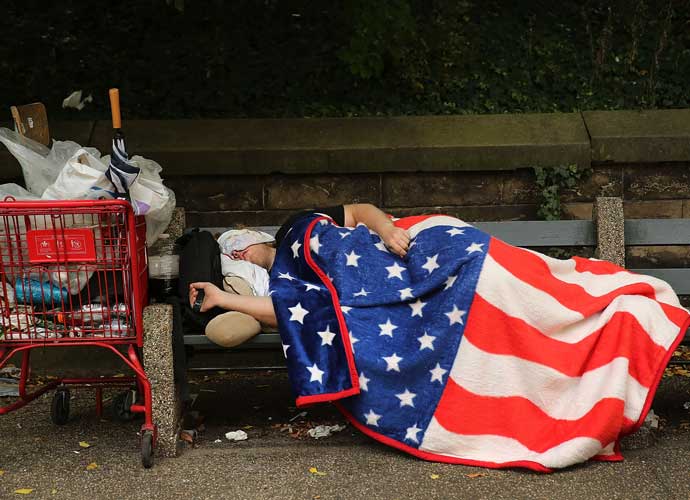Jason Connery, Sean Connery’s Son, Talks Directing His Movie ‘Tommy’s Honour’ [VIDEO EXCLUSIVE]
Jason Connery, the director of the new film Tommy’s Honour, recently sat down with uInterview to discuss the movie, the history behind the story, and all the work that went into making it a reality.
Tommy’s Honour tells the story of Tom Morris and his son Tommy, who were essentially the founders of the modern game of golf. Before the Morris boys, golfers played on behalf of wealthy gamblers rather than for themselves. Tommy Morris, who was considered lower-class and an incredible golfer, decided to play only for himself and unknowingly revolutionized the game.
Connery first heard the story after reading the book of the same name by Kevin Cook in one sitting. He was enthralled and excited to make the story into a film.
“I read [Tommy’s Honour] in one sitting and it’s an amazing story all about Tom Morris and his son Tommy Morris. But really, ostensibly, it is about a period of time, what would be considered the beginning of the new era of golf,” Connery told uInterview exclusively.
“But the other side of the story that was really compelling to me, outside of the golf, was the family drama and the love story, one between young Tommy and his wife Meg and also the family drama in the Morris household between the father and son.”
With the family drama as the centerpiece, Connery, who is the son of the acting legend Sean Connery, hoped most of all to cast two people that bring that dynamic to life on the screen. And he found those two in Jack Lowden and Peter Mullan.
Said Connery, “Really, they are wonderful together and their chemistry was, one, because of their talent, but also luck because I think they really hit it off and really enjoyed each other.”
But beyond Mullan and Lowden, Connery was able to stack the film with actors that he has known for a long time, making the set a fun place to be.
“I was able to ring people up that I hadn’t seen, or had seen, but had worked with 30 years earlier, and invite them to come be in the film. One of the caddies with a big top hat who is wonderful in the film, Andy Gray, I’ve known since I was 19. So it was wonderful to have friendly faces.”
With all the work from the costume designers, set designers, and a friendly group of actors, Connery only hopes that his film takes viewers inside the world that his team has created.
“For me, the highest praise, is when people who see the film, feel as though they were there, that they were in it,” said Connery. “My thing about period, movies about sport, about family dramas is that I don’t want people to feel as though they were outside, looking in.”
Watch the trailer for Tommy’s Honour below. The film is now available on Blu-ray.
Five years ago I was sitting in my cottage in Scotland in the Boarders, which incidentally is about a two and a half hour drive from where the story takes place in Andrews. I got a phone call, when I was sitting in the cottage, from an American producer named Jim Kreutzer, and he had bought the rights to the book – there's a book that came out in 2007 called 'Tommy's Honour' written by Kevin Cook – and it told the entire story. I read it in one sitting and it's an amazing story all about Tom Morris and his son Tommy Morris. But really, ostensibly, it is about a period of time, what would be considered the beginning of the new era of golf. At that time, there were really only 13 rules of golf, no there's about 5,000, so it was certainly different. That was something I was hugely drawn to because it was the beginning. They carried their clubs and one of the rules was that you teed off no more than a club's length from where the hole was so Tom would spend so long trying to get the greens right and guys would put the ball down a club's length and smack the ball from there and turn up his greens. But the other side of the story that was really compelling to me, outside of the golf, was the family drama and the love story, one between young Tommy and his wife Meg and also the family drama in the Morris household between the father and son ostensibly but also the mother, Nancy. It was multilayered, the story, because you have the upper and lower class scenario at that time and also how powerful religion and the church was in their society. So there were many things to look at and I felt like the story was universal in its appeal. These guys were extraordinary golfers in their own right. Certainly Tommy was extraordinary and prodigious, he won the first Open at 17 and then won it three times in a row, kept the belt because that was part of the rules, and they had nothing to play for in the fourth year so they didn't have a British Open, and then they got a cup, which is now the famous Claret Jug. His name is the first name on the jug, his father won and his father was the oldest so they bookend each other like that. Tommy had an extraordinary life, he was a real shooting star and ultimately had a very tragic end to his life, which I wont reveal too much more about because you have to go and see the film.
The crowd at that time were absolutely, viscerally, right next to the players, and they were shouting, and they were gambling, and they were drinking, and they were smoking. They had this energy and vitality and it was a very different type of game. It was wonderful to be able to show the beginnings of something and where it has gone to. I mean, there are 70 million people who play golf. It's a very polarizing game. They either love it, or they hate it. And these men had no sense of their own legacy and they created something that people should know about.
I've been an actor as well as a director and I've had the happy adventure – it always is – of working with Peter Mullen. He was playing a mystical magician in a television show I did called 'Shoebox Zoo,' a children's television show, and I was playing the father of the lead girl. I only had a couple of scenes with Peter but even those I recognized that he was such a fantastic actor. He's very relaxed and very different than one might envision him because he's actually lovely because he talks and tells stories and is a joy to have on set – ironically because he often plays very dark, brooding characters. I just remember that when we really started to hone the script and really work with the writers I thought, 'Wow, Peter Mullen to play Old Tom would be absolutely perfect.' To his credit, I rang him and couldn't understand why he sounded so groggy and then I find out he was actually in New Zealand and it was actually four o'clock in the morning for him. So that was quite embarrassing but he was great about it. I said, 'Look, I've got this script, I've been working very hard on it and I'd love for you to read it and to play old Tom.' He knew nothing about the story or of the Morris family, he'd never played golf. But he read it and called me the next day and said, 'If you want me, I'm in.' And that was the beginning of the process. And, you know, when you're casting things you really need someone to step up like that and then it starts to fall into place. Jack Lowden, continually working now, wonderful actor. Really, they are wonderful together and their chemistry was, one, because of their talent, but also luck because I think they really hit it off and really enjoyed each other. Ironically I was in America and I Skyped with him. He's quite serious and intense but when he laughs and when he gets enthused it just jumps from every pore, and they really are wonderful together. As we built the cast, to have those two in place and Ophelia Lovibond, who is wonderful as Meg, Therese Bradley who plays Nancy, the wife of Tom, Peter Ferdinado, and of course, Sam Neill, who everyone will know from 'Jurassic Park' and various other shows. Lovely. What was wonderful was I started acting up at Perth Rep, in Scotland, so I was able to ring people up that I hadn't seen, or had seen, but had worked with 30 years earlier, and invite them to come be in the film. One of the caddies with a big top hat who is wonderful in the film, Andy Gray, I've known since I was 19. So it was wonderful to have friendly faces.
I'm enormously proud of many aspects of the film. Obviously, I didn't do all of the things in the film – there's wonderful acting, and costumes, and make-up – all the different elements. But the fact that one is able to galvanize everyone to make something that other people could be taken to that world. And for me, the highest praise, is when people who see the film, feel as though they were there, that they were in it. My thing about period, movies about sport, about family dramas is that I don't want people to feel as though they were outside, looking in.
The biggest hardship in making the film were just logistical as far as how many days we had to shoot. We shot the whole movie in 33 days and we had 50 locations. So we were moving at a pace where everyone needed to be on their game, and the were. We never went over a day and we never went over budget. In that sense, that feels good. The wonderful thing about period movies is that it doesn't age so hopefully it will be played for a long time.
RELATED ARTICLES
Get the most-revealing celebrity conversations with the uInterview podcast!



![Jason Connery, Sean Connery’s Son, Talks Directing His Movie ‘Tommy’s Honour’ [VIDEO EXCLUSIVE]](https://cdn-o9.uinterview.com/wp-content/uploads/2017/06/Jason_Connery.jpg)





Leave a comment